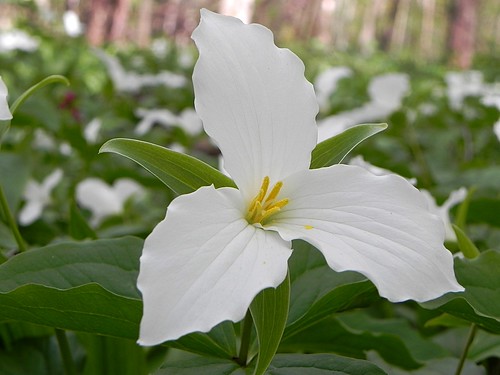Wildflowers explode across the forest floor like a slow moving fireworks show. It starts with a trickle of hepatica, then bursts with thousands of pink and white Spring Beauties blooming en masse. Then, bright yellow Trout Lilies bloom in bursts scattered through the forest. Trilliums appear after that, forming masses of white and maroon. The forest changes week by week each May as wildflowers burst out in full color, then disappear while another flower bursts out.
The flowers don’t really disappear. Many of these perennials are probably older than I am and grow from the same root each year. Their flowers disappear, but the plants linger for weeks or months as they create seeds to spread their little plant babies about the forest. Later, they die back completely and leave their space open for a new flower to fill later in the season.
Every forest has its own wildflower show. I try to visit as many as I can to see as many flowers as possible each spring. One forest has Virginia Bluebells and Rue Anemone. Another has trillium as far as the eye can see. Another has delicate waves of Early Meadow Rue, with flowers that remind me of delicate waterfalls. Other forests are filled with leeks or delicate Wild Oats.

One thing we have learned to watch for over the years is hunters. Deer hunters are essential for a beautiful, diverse plot of wildflowers. Herds of deer that grow each year eat the delicate, tasty flowers first. Forests with too many deer often become forests dense with ferns and plants the deer don’t like as much. Deer eat the wildflowers right to the ground. The best flower hikes are often on land that is hunted each fall.
Week by week, the forest changes and new flowers appear. My wife and I managed to visit one forest on exactly the right day to see hundreds of Bloodroot in bloom. These spring plants only last a week or so. Every year since, we have attempted and failed to see that sight again. The flowers emerge on their own timetable that varies each year that varies with warmth, rainfall and snowmelt. They are difficult to predict.
There was a time when I tried to predict this timetable and schedule a wildflower walk months in advance. This year, Audubon is offering a weekly 3:00 p.m. Wildflower Walk at Werner Park in Russell, Pa to get a weekly look at the wildflower show. Wildflowers started early this year during the 80 degree days in April, but there are still many flowers to be seen. This short walk through mostly flat forest showcases a lot of the local wildflowers and the varieties change each week.
I learned wildflowers early on as a naturalist simply because they don’t move. A plant is easy to meet and get to know. My wife and I used to sit down on the trail, pull out a field guide and leisurely identify the plant while relaxing in the forest. This isn’t possible with birds, who dart and flit through the branches, hiding as much as possible while you try to figure them out.

Wildflowers, though they come back each year, can be surprisingly delicate. Many only bloom once every several years, though you might not notice in a forest full of flowers. Dozens bloom each year, but they are different dozens each time. Many of the plants rest on the forest floor, collecting sunlight and storing energy until they have enough oomph to blossom.
Picking those flowers can cause them to lose all their stored energy. Trilliums littered the ground on one trail we hiked the other day. It looked like a child had made a bouquet of trillium and daffodils and scattered them on the trail as they hiked. Those trillium may take years to recover, if they don’t die from the picking.
Another time, a friend’s child ran up with a bouquet of beautiful yellow Trout Lilies. It was beautiful, but heartrending. It’s hard to watch when you know, deep down in your gut, that the plant stored energy for seven years or more to be able to bloom and create seeds only to have seven years of work undone in under a minute for a bouquet that was soon mashed by the trail.
Regardless, the wildflower show is amazing in May. Find some time to go for a hike in your local forest or park. Look at the ground and see what changes week to week. You might be surprised by how much you can find in the same area as the slow explosion of flowers unfolds.
Audubon Community Nature Center builds and nurtures connections between people and nature. ACNC is located just east of Route 62 between Warren and Jamestown. The trails are still open from dawn to dusk but Liberty, the Bald Eagle is currently off display during the construction of the Pamela A. Westrom Wildlife Habitat. You can visit her on her Facebook page. The Nature Center is partially open, including restrooms, the Blue Heron Gift Shop, and some exhibits. More information can be found online at auduboncnc.org or by calling (716) 569-2345.


Recent Comments